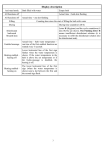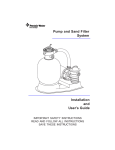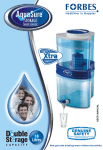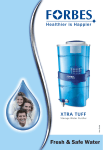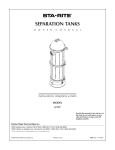Download Tulip Siphon Water Filter
Transcript
Tulip Siphon Water Filter Instruction manual What this filter removes This filter will remove: Bacteria Turbidity Parasites Bad taste and residual chlorine This will prevent diseases like: diarrhea, cholera and typhoid. The filter and its elements How to make your drinking water safe The speed of filtration is faster when the container with contaminated water stands at a higher level. www.basicwaterneeds.com How does it work? 1. Place the upper container with dirty water about 70 cm above the lower container with the clean water. 2. Use the red ring to adjust the length of the hose. 3. If you have a new filter (element), let the filter stay in water during one night and do not use the first 20 liters (about two buckets) of filtered water, this will not taste good. 4. Open the tap and press the bulb. 5. Wait until the bulb slowly has been filled and the water starts flowing out of the tap. If the filter is new or dry this has to be repeated a few times till the water starts flowing by itself. 6. The Tulip Siphon filter will purify the water of bacteria, parasites and turbidity. 7. It is recommended to catch the clean water in a container with a tap and lid. If not and water is taken out with a cup, make sure cap and hands are clean. Maintenance: Backwashing When the filter element becomes dirty, the water flow will reduce. Therefore it is important to frequently wash the filter. 1. The Siphon filter can be backwashed. Do this after each bucket that you have filtered. Close the tap and firmly press the bulb. Water will come out of the filter element (make sure you remove the filter from the containers while pressing). 2. Put the filter back in the water, wait until the bulb is filled again with water and open the tap. 3. If necessary, repeat this a few times until the flow rate is back to normal. 4. Frequent back washing will result in a longer lifetime of the filter. Maintenance: Cleaning 1. When the water is very turbid, use the prefilter. When the prefilter becomes dirty, remove the pre-filter from the ceramic element and wash it in clean water. 2. When the flow remains to slow, even after backwashing, clean the filter with a toothbrush or a cloth. 3. If backwashing and cleaning does not increase the flow, the filter element has to be carefully cleaned with the round scrub pad. Remove only as little as possible from the ceramic material, as this will shorten the lifetime of the element. Rinse with clean water while scrubbing. When to replace the filter? When the filter diameter becomes too small because of scrubbing, the filter element has to be replaced. With the plastic sensor you can measure when your filter has to be replaced. When the plastic sensor fits around the thinnest part of the filter, the filter is no longer safe to filter the water and it has to be replaced. Ask your local supplier for the replacement filter. www.basicwaterneeds.com How to replace the filter? 1. Unscrew the old filter element from the cover. 2. Cut the hose near the nozzle with a knife. 3. Screw the new filter through the cover and connect it to the hose. . Key features Fast flow Unique end of life sensor Back wash function Will last for 7000 liters More information www.basicwaterneeds.com Designed in the Netherlands, manufactured in India


